Growth, Confidence, and the Future
Diocesan Synod looks with confidence at rural church, new housing, schools, and our Cathedral
Growth and confidence in the future were a major themes of the November 2017 meeting Diocesan Synod, which took place on Saturday at Sarum Academy in Salisbury.
As Bishop Nicholas noted in his opening address Sarum Academy was itself an extraordinary story of transformation and growth – after some challenging times, the school’s most recent Ofsted report saw it rated good in all areas.
Before that address, however, Synod began worship. The readings, Joshua’s entry to the Promised Land, and Jesus’ Great Commission to the apostles, set the right tone for the day’s proceedings.
In his Presidential Address, Bishop Nicholas welcomed Gillian Clarke as new Chair of the House of Laity.
Read Bishop Nicholas’ full address here.
There is much difficult news at present. However, as the Rector of Shaftesbury, the Revd Helen Dawes, noted in September, when the Church does well in difficult situations, it has an impact on the whole community.
The Bishop helped judge the Church Times Green Awards. There were imaginative entries from around the country, including Holy Trinity, Bradford on Avon, setting a new standard for what is possible for churches in this field. Brother Hugh received an award on behalf of Hilfield Friary for long periods of leadership.
Bishop Nicholas noted we had now had a very long period of austerity, of almost a decade, which was seeing frustration put our values to the test. He had seen this twice in his life before. The Church must, by definition, have a concern for the poor.
He recently hosted a reception in Parliament for young migrants who had been in the Calais Jungle and accepted into the United Kingdom, who wanted to thank Parliament and the country for their welcome (news story here). Is welcome how our reception of refugees feels to us, he asked. There were harrowing stories, which can only really be told face-to-face. One 15 year-old from Helmand Province in Afghanistan, was sent away by his family after being given a choice to join Taliban or face the consequences. Half the people in his truck he fled on died.
We must think of how outsiders are used by Christ in the Gospels to show us what really matters, which was part of what he thought was going on at that reception.
The Diocese had recently launched its #RuralHope programme: while in some ways a small proportion of our overall spending, it is an important piece of work.
Growth is more difficult than praying and serving. There were some successes already, however, Vocations to ordained and lay ministry have grown, and have nearly reached the target of a 50% increase the Diocese set itself for ordained ministry. The focus on discipleship is paying fruit. Further, there has been a 10% increase in Confirmations in 2017, showing the work of Neil Larkey is bearing fruit. As Young People’s Confirmation Project Worker Neil’s is a central appointment that works locally.
The decision was taken to give Pray, Serve, Grow 5 years before assessing how it is making a difference. The process building towards that review will begin after the January Bishop’s Council residential, and will examine church growth in a range of contexts.
Bishop Nicholas concluded by nothing that nothing in the voluntary sector inspires as much commitment as the Church of England.
The Diocesan Secretary then asked members to remember John Lello and Beth Buchan, committed members of Synod who have recently passed away.
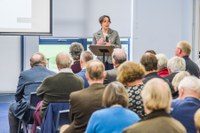 The next item of business saw Jill Hopkinson, National Rural Officer for the Church of England, talk about rural mission.
The next item of business saw Jill Hopkinson, National Rural Officer for the Church of England, talk about rural mission.
Rural communities have changed significantly in recent decades. There are more than 10,000 rural churches in England, ⅔ of them Church of England. That means there is one Anglican church for every 1,000 people in rural England. Therefore, small rural churches are not a failing churches, just as a satsuma is not a failed orange! The proportion of churchgoers in the countryside is higher than
in the towns, and many prefer the intimacy of a small congregation. But it’s hard work to keep a small congregation thriving.
Deep and relevant mission is possible in rural multi-church groups, but this depends on an intentional focus on mission and evangelism beyond Sunday worship, a committed group of lay people with easily accessible training and support and a culture of discipleship. There was a need to free up time from admin and buildings. Clergy needed to envision, nurture and equip lay leadership. Co-operation and collaboration between multi-church groups and ecumenically was also vital.
Parishes needed to explore having “church children”, congregations gathering at different times and in different ways, reaching parts of the community they don’t already.
Despite popular misconceptions, a similar proportion of rural churches grow to urban ones. We are not good at seeing success in the rural church and affirming those within it.
The body of Christ in the rural church is incarnational, fitting the pattern set out by St Paul.
Research shows that rural parishes and small congregations have the greatest reach into the wider community. In bigger congregations, it can be harder for gifts of lay people to be released.
Above all, growth must be dependent on God: the first ingredient needed for a growing church is prayer and more prayer! Time and patience is also needed.
This was followed by lively discussion.
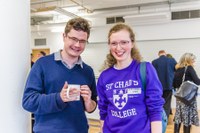 The Diocesan Secretary, Lucinda Herklots then introduced the Renewing Hope through Rural Ministry and Mission scheme aka #RuralHope.
The Diocesan Secretary, Lucinda Herklots then introduced the Renewing Hope through Rural Ministry and Mission scheme aka #RuralHope.
This is a major new programme aimed at identifying rural lay and clergy leaders of the future and equipping and empowering those of the present (full details here). Amy and William from the rural ministry experience scheme for young adults considering ordination are here as observers.
Five candidates have started at Sarum College this year on the new Rural Training Programme, and a rural training co-ordinator will be appointments. Rural placements for mid-career clergy will start in Summer 2018, and all curates now expected to do a rural placement between the 3rd and 4th years of curacy. Two people have already started the Germinate rural leadership course this year.
A programme manager has been appointed, Sarah Keen, who lives and worships in Beaminster and is training as a Licensed Lay Minister, and she starts on Tuesday.
Lucinda concluded with the deeply counter-cultural and stereotyping phrase, “If you have dreams to dream, talk to your Archdeacon.”
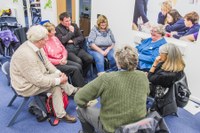 The Ven Alan Jeans, Archdeacon of Sarum then introduced a motion to ratify a policy on ministry in new housing estates, requested by Bishop’s Council. This accompanies the church buildings and church planting policies agreed at last November’s Synod. There are already 46,000 new homes coming on stream across the Diocese, implying a population increase of over 10%. The national housing shortage means there is, as in previous periods of national history, likely to be significant further new constriction of housing estates. The government currently plans to see a million new homes by 2020 with a further half a million by 2022.
The Ven Alan Jeans, Archdeacon of Sarum then introduced a motion to ratify a policy on ministry in new housing estates, requested by Bishop’s Council. This accompanies the church buildings and church planting policies agreed at last November’s Synod. There are already 46,000 new homes coming on stream across the Diocese, implying a population increase of over 10%. The national housing shortage means there is, as in previous periods of national history, likely to be significant further new constriction of housing estates. The government currently plans to see a million new homes by 2020 with a further half a million by 2022.
A new housing hub has been meeting since 2014 to plan for these changes. A number of pioneer posts have been created to support this work with a pioneer priest in Gillingham, pioneer ministry in Melksham, and Poole Missional Communities, which while not specifically aimed at new housing per se, is surrounded by one of the largest developments of new housing the UK in Central Poole.
In Warminster, worshippers at Christ Church sold their houses to buy on new estates in the town and ensure a Christian presence there.
These new homes aren’t just places to live, but represent changes in society and politics, public health and well-being, and also the growing gap between property owners and renters, between wealth and poverty. There is a need to have the presence of Christians who know that God’s love helps everyone and can transform lives for the better.
The motion was passed unanimously.
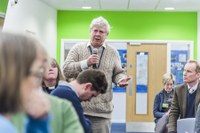 After the lunch break, Acting Dean of Salisbury, the Revd Canon Edward Probert gave the Cathedral’s annual report to Diocesan Synod.
After the lunch break, Acting Dean of Salisbury, the Revd Canon Edward Probert gave the Cathedral’s annual report to Diocesan Synod.
After the 800th anniversary of Magna Carta in 2015, a quieter year was expected in 2016. This isn’t what happened! Visitor numbers were down a bit at the beginning of the 2016-17 financial year from their Magna Carta peak, but rebounded strongly at the end.
The Cathedral volunteers were deservedly granted the Queen’s Award for Voluntary Service, the highest award a group of volunteers can be granted.
The peregrine falcons nesting in the tower have become major celebrities thanks to the power of the webcam, with followers across the country especially during hatching season.
A very special occasion was the collaboration between the Cathedral, the Cathedral School, La Folia Music and Exeter House Special School for Evening Songs. The Cathedral choristers sang with children from Exeter House, breaking down barriers in a special way. Held at the time of a conventional weekday Choral Evensong, this was one of the most powerful acts of worship many of those attending had ever experienced. A new Youth Choir of teenagers was launched, who join with the Cathedral choristers and Children’s Choir on major occasions like Palm Sunday. This was all a fittingly stereotype-shattering context in which to celebrate the 25th anniversary of the Girl’s Choir.
The Cathedral, following Bishop Nicholas’ agenda and led by the Revd Canon Robert Titley, Canon Treasurer, won an Eco Church Bronze award (more info on Eco Church here).
Wiltshire Council has unanimously agreed the Cathedral masterplan looking forward 50 years.
Not least, the previous Dean, has gone to be Bishop of Llandaff and is now the Rt Revd June Osborne. She was with the Cathedral Choir on tour in California when she heard the news.
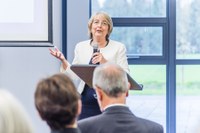 The final item on the agenda was especially significant, the Diocesan Board of Education’s annual report to Diocesan Synod.
The final item on the agenda was especially significant, the Diocesan Board of Education’s annual report to Diocesan Synod.
Diocesan Director of Education, Canon Joy Tubbs noted the huge changes in the education system. Christian distinctiveness is something to hold on to in that journey. There is an increasingly two-tier system with schools in Multi-Academy Trusts and Local Education Authority schools. By Easter, half of the Diocese’s schools will be in MATs. When that direction of policy became clear, it was decided the Diocese needed its own MAT, called DSAT, which now covers 13 schools.
One especially exciting piece of news is that the first new church primary in the area for 14 years, St Peter’s will open next September at the new development between Bemerton Heath and Wilton.
Mark Lacey, Chief Executive of the DSAT explained that as well as the 13 primaries, DSAT may soon have an opportunity to work with secondaries. Some of the schools have a history of challenge going back years or even generations. Many came into DSAT as a result of very challenging Ofsted inspections. School improvement was therefore at the heart of DSAT’s mission. Real progress has been made, with some rapid turnarounds acknowledged in Ofsted interim reports.
At the same time, the schools have all become distinctively Church schools, which not all were before, and there is now there is real Christian distinctiveness in all of them. To maintain that, good Foundation governors are needed; a new Chair of Governors will also be needed at St Mary’s, Beaminster, as a longstanding incumbent is retiring.
The final formal speaker of the day was Sarah Patterson, Head Teacher of St Andrew’, Weymouth, who has transformed a school into DSAT membership for the second time! She previously took Tent Young’s outside Sherborne into DSAT. As well as school improvement and Christian distinctiveness, what she most appreciated from DSAT was a sense of joy.
There was no chance of late afternoon energy levels flagging at that point, however, as the magnificent children from Dunbury school, based in Winterborne Kingston and Winterborne Whitechurch, told synod members of their achievements from learning Japanese to the Lion King to Singapore Maths. This is a small school serving three tiny villages, yet achievements are easily the equal of much larger outfits.
The Board of Education also worked with 15 head teachers over the past year to discuss what it means for a school to be deeply Christian. They are working with the senior leadership at all 16 Diocese of Salisbury secondary and middle schools to discuss what it means to be a worshipping community, and how to make collective worship a real act of worship.
180 head teachers and their RE co-ordinators attended conferences to discuss how to teach theological concepts to 5-18 year olds. For 5 year olds that might involve asking, for example, what forgiveness means. It is very challenging but our RE teachers and heads are learning how to meet that challenge.
A special acknowledgement was given to the Gryphon secondary school in Sherborne which has just won Teaching School status.
Closing worship concluded at 3.09 pm – not quite early enough to see the first half of the rugby!
Document Actions


